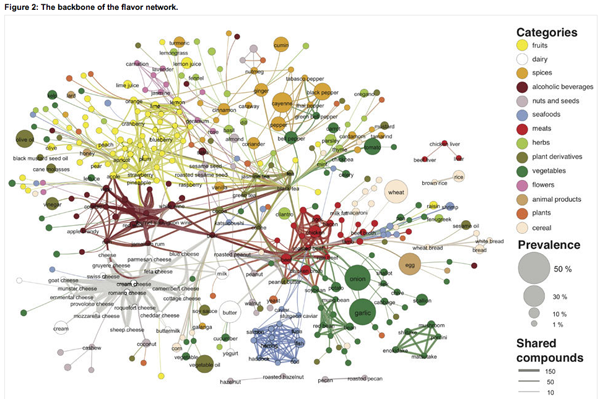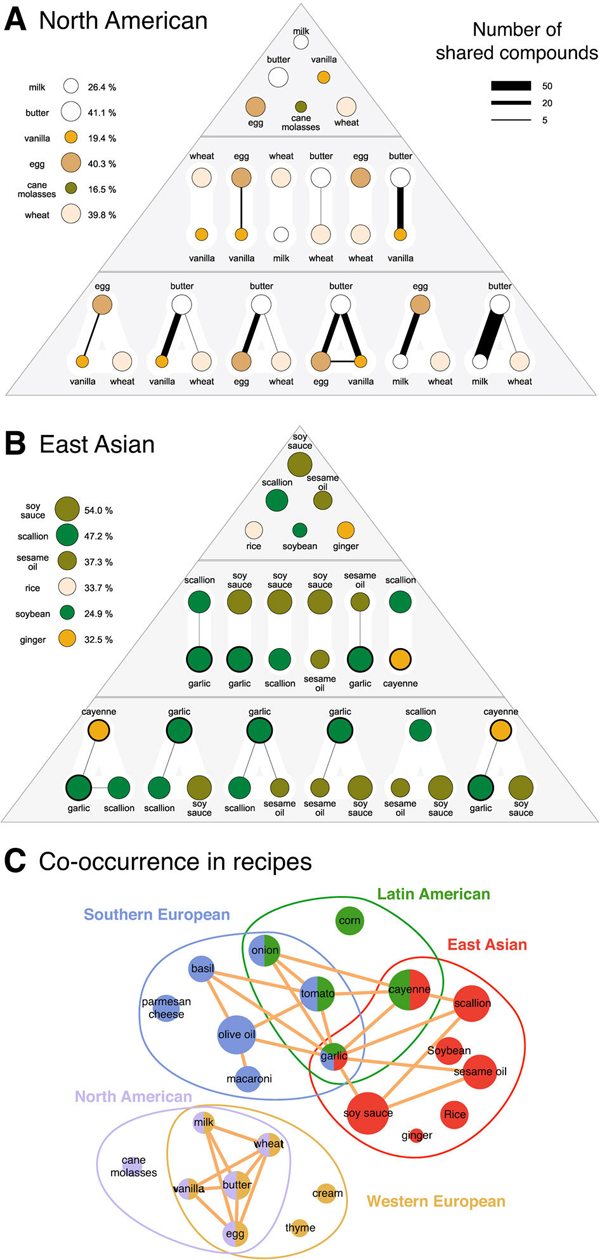
Each node denotes an ingredient, the node color indicates food category, and node size reflects the ingredient prevalence in recipes. Two ingredients are connected if they share a significant number of flavor compounds, link thickness representing the number of shared compounds between the two ingredients. Adjacent links are bundled to reduce the clutter. Note that the map shows only the statistically significant links, as identified by the algorithm of Refs.28, 29 for p-value 0.04. A drawing of the full network is too dense to be informative. We use, however, the full network in our subsequent measurements.
What Works
Trying to visualize the connections between flavors (ingredients?) is a new direction for both visualization and network research, though there has been some work on which flavors/ingredients tend to go well together (see Michael Ruhlman’s “Ratio” for basic recipe ratios and a bazillion cookbooks for specific flavor/ingredient combinations). In fact, the researchers for this article used the 56.000+ recipes at allrecipes.com, epicurious.com, and menupan.com (a Korean recipe site) to generate the network above, clearing out the noise by displaying only the biggest nodes which are the most commonly occurring ingredients.
What the researchers were after was figuring out whether similar ingredients are more likely to attract or repel each other. They broke the common ingredients down into their chemical components to help measure similarity and examined American and Korean recipes both lumped together and separately. In the separated case, they found that, “The results largely correlate with our earlier observations: in North American recipes, the more compounds are shared by two ingredients, the more likely they appear in recipes. By contrast, in East Asian cuisine the more flavor compounds two ingredients share, the less likely they are used together.” However, they figured out that some combinations of ingredients appeared so frequently in both cuisines that they were skewing the results. Americans like to use milk, butter, cocoa, vanilla, cream, and egg together. East Asians have a lot of recipes that use beef, ginger, pork, cayenne, chicken, and onion. When you sort these ingredients out, the networks are kind of silly because, at least in the American case, at least one of the ingredients on the ‘frequent’ list appears in about 75% of the recipes.
Next, they honed in on these co-occurring ingredients/flavor compounds and constructed what they call an “authenticity” score. Quoting the authors, “If an ingredient has a high level of authenticity, then it is prevalent in a cuisine while not so prevalent in all other cuisines.” The figure below highlights the ingredients, ingredient pairs, and ingredient triplets that scored high on “authenticity” using pyramids.

Personally, what I think this shows is that Americans like to bake much more than anyone else or at least that they are more likely to use recipes to bake. Baking is thought to be the more exacting of the cooking/baking pair, and thus would be more likely to require a recipe than would cooking. Again, I refer you to Michael Ruhlman’s “Ratio” in which he somewhat disputes the necessity of following recipes in favor of memorizing and then following ratios.
As for the success of the graphics here, I admit that I would not have read this article had it not been for the graphics. I find the methodology interesting though the findings are the kind of findings that make a lot of people shrug their shoulders and say, “um, that’s nice.” Another networks researcher, Duncan Watts, came out with a book earlier this year called: “Everything is obvious, once you know the answer” in which he argues for the kind of science that offers testable mechanisms for assessing the things we think are true. I guess if we take his point, we can feel more confident in our pronouncements about what makes American food American or East Asian food East Asian. Yes, area studies people, I know that East Asian food varies and that the trends they find in American food might also be discovered in French food. I’m just using the categories they worked with rather than those established by food studies scholars and cooks.
References
Ahn, Ahnert, Bagrow, and Barabasi. (15 December 2011) Flavor Network and the Principles of Food Pairing. Nature: Scientific Reports 1: Article 196.
Ruhlman, Michael. (2009) Ratio: The simple codes behind the craft of everyday cooking. Scribner.
Watts, Duncan. (2011) Everything is obvious, *once you know the answer. Crown Business.
